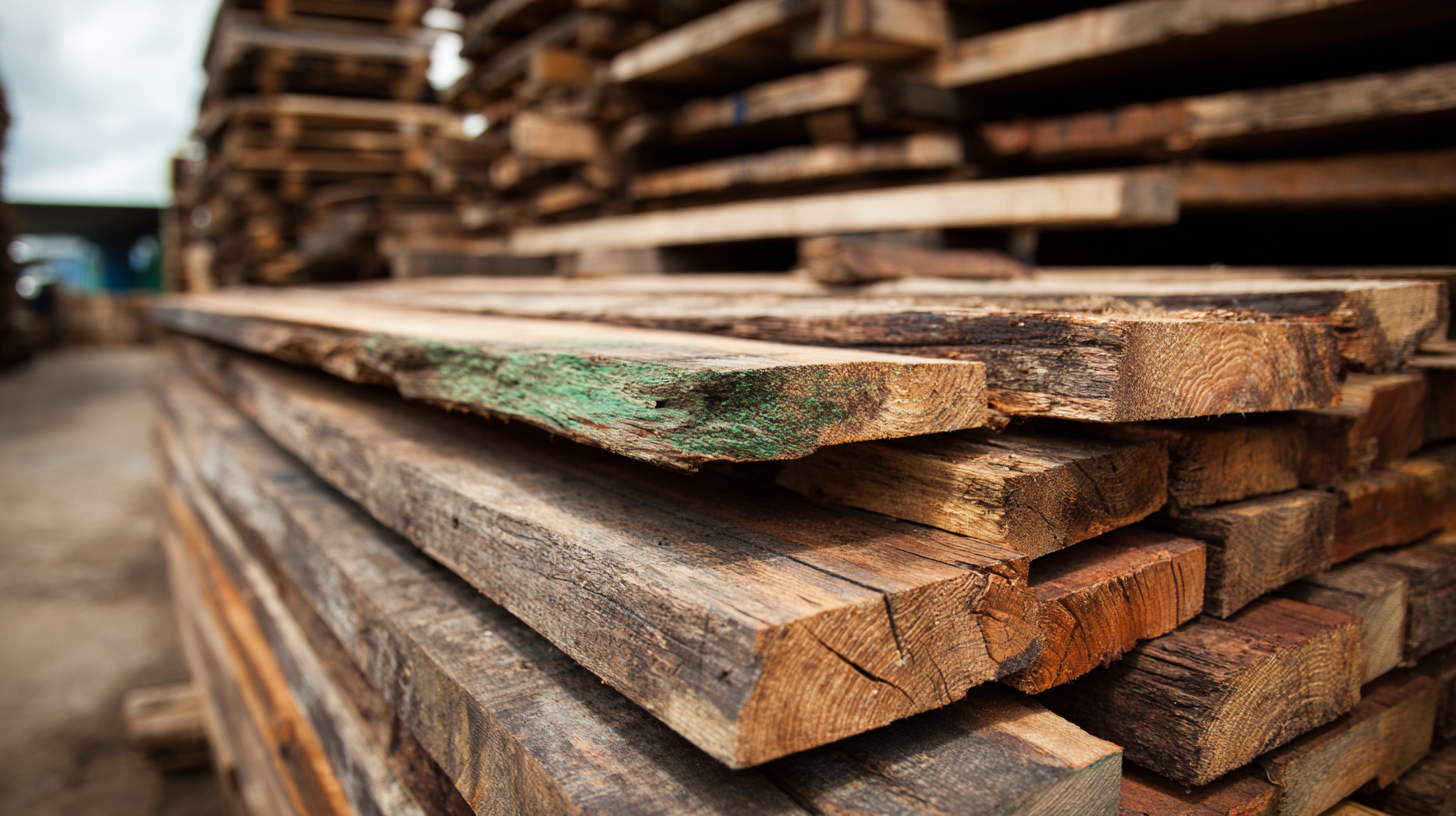The Hidden Benefits of Choosing Recycled Wood for Sustainable Living
In the pursuit of sustainable living, the choice of materials plays a pivotal role, and one standout option is recycled wood. According to the Environmental Protection Agency (EPA), nearly 36 million tons of wood waste are generated annually in the United States alone, and utilizing recycled wood can significantly mitigate this waste. Studies estimate that using recycled wood can save approximately 25% more energy compared to harvesting new wood, while also reducing carbon emissions by nearly 33%. Furthermore, the use of recycled wood supports the circular economy by extending the life cycle of timber and minimizing the demand for new logging, which can lead to deforestation and habitat loss. This article will explore the hidden benefits of choosing recycled wood, emphasizing its role in promoting both environmental sustainability and economic viability for individuals and communities alike.

The Environmental Impact of Recycled Wood in Sustainable Practices
Choosing recycled wood for sustainable living presents numerous environmental benefits. Recycled wood significantly reduces the demand for new timber, thereby conserving precious forests and promoting biodiversity. By repurposing existing materials, we diminish the energy-intensive processes associated with timber harvesting, such as deforestation and transportation. This shift not only lowers carbon emissions but also helps maintain essential ecosystems that are vital for wildlife.

Tips: When selecting recycled wood products, ensure they come from reputable sources that adhere to sustainable practices. Look for certifications like FSC (Forest Stewardship Council) to guarantee that the wood has been properly managed and sourced. Additionally, consider incorporating items made from reclaimed wood in your home. Not only do they offer a unique aesthetic, but they also contribute to a circular economy, reducing waste and extending the lifespan of wood materials.
The use of recycled wood also aids in waste reduction. By diverting wood from landfills, we minimize the environmental impact associated with waste management. Every piece of recycled wood contributes to a decrease in landfill mass, thereby lowering methane emissions and promoting a healthier planet. Incorporating recycled wood into your building projects or furniture not only enhances your home’s character but also aligns your lifestyle with sustainable practices.
Exploring the Aesthetic Appeal of Recycled Wood in Interior Design
Recycled wood has gained considerable attention in the realm of interior design, not just for its environmental benefits, but also for its unique aesthetic appeal. According to the 2021 National Association of Home Builders report, 75% of homeowners expressed a preference for sustainable materials in their renovation projects, with recycled wood topping the list due to its character and warmth. Each piece of recycled wood tells a story, adding authenticity and charm that new materials often lack. The natural variations in color, grain, and texture create a rich tapestry that can enhance both modern and traditional interiors.

Furthermore, the use of recycled wood can elevate a space through its versatility. A 2022 survey by the American Institute of Architects found that designers increasingly utilize reclaimed wood in various applications, from flooring to accent walls and furniture pieces. This rise in popularity is closely associated with the trend towards biophilic design, which emphasizes a connection to nature. By incorporating recycled wood, homeowners not only contribute to sustainability but also create inviting environments that reflect a timeless aesthetic. The marriage of form and function makes recycled wood an indispensable choice for those looking to combine style with eco-conscious living.
Economic Advantages of Using Recycled Wood in Home Renovations
Recycled wood is becoming a preferred choice for homeowners looking to renovate sustainably, not only for its environmental benefits but also for its economic advantages. According to a report by the National Association of Home Builders, utilizing recycled materials can save homeowners up to 30% on renovation costs compared to using new materials. This cost savings arises from various factors, including lower disposal fees for construction waste and the often-lower price point of reclaimed wood products.
Furthermore, the use of recycled wood can increase a home's resale value. A study published by the U.S. Green Building Council found that homes featuring sustainable materials, including recycled wood, sold for a premium—around 10% more than comparable homes without sustainable features. With the growing market demand for eco-friendly homes, investing in recycled wood not only contributes to a healthier planet but also positively impacts the bottom line for homeowners looking to maximize their renovation investments.
The Hidden Benefits of Choosing Recycled Wood for Sustainable Living - Economic Advantages of Using Recycled Wood in Home Renovations
| Dimension | Recycled Wood | New Wood | Savings |
|---|---|---|---|
| Cost per Square Foot | $4.00 | $6.00 | $2.00 |
| Carbon Footprint Reduction | 50% | None | N/A |
| Durability | High | Variable | N/A |
| Aesthetic Value | Unique Character | Uniform Appearance | N/A |
| Supply Chain Impact | Supports Local Economy | Global Sourcing | N/A |
Health Benefits of Choosing Recycled Wood Over New Materials
Choosing recycled wood over new materials offers significant health benefits that are often overlooked in discussions about sustainable living. According to a report by the National Association of Home Builders, homes constructed with reclaimed wood can improve indoor air quality by reducing the number of volatile organic compounds (VOCs) released into the environment. These VOCs, which are commonly found in new materials such as paints and adhesives, can lead to respiratory issues and other health problems. In contrast, recycled wood typically undergoes minimal processing, resulting in fewer emissions and a safer living environment.
Moreover, using recycled wood can also impact mental well-being positively. A study published in the Journal of Environmental Psychology highlights that natural materials in interior design, such as reclaimed wood, contribute to reduced stress levels and increased comfort. The tactile nature of wood, combined with its aesthetic appeal, creates a tranquil atmosphere that promotes relaxation and mental clarity. With more consumers recognizing the psychological advantages of biophilic design, the demand for recycled wood in home construction and renovation continues to rise, showcasing its dual benefit for both the environment and occupant well-being.
Innovative Uses of Recycled Wood in Contemporary Architecture
Recycled wood is making waves in contemporary architecture, offering architects and builders innovative solutions that marry aesthetic appeal with sustainability. According to a recent report from the U.S. Forest Service, using recycled wood reduces greenhouse gas emissions by approximately 32% compared to sourcing new timber. This significant reduction is due to the avoidance of harvesting new trees, which contributes to deforestation and habitat destruction. Architects are now creatively integrating reclaimed wood into diverse applications, such as structural elements, flooring, and furniture, thus enhancing the character and warmth of modern spaces.
One acclaimed project, the Bullitt Center in Seattle, utilized reclaimed wood for its interiors, showcasing not only the material's beauty but also its contribution to LEED certification. This building has been recognized as one of the greenest commercial buildings in the world. The versatility of recycled wood allows it to be transformed into unique design features—from beams and trusses to exquisite paneling, thus making it a favored choice among designers striving for aesthetic uniqueness.
**Tips:** When selecting recycled wood, look for products that are certified by organizations such as the Forest Stewardship Council (FSC) to ensure sustainability. Additionally, consider local sources for reclaimed wood to reduce transportation emissions. Lastly, think creatively; even scraps of recycled wood can be repurposed into stunning accent pieces, proving that sustainability does not compromise style.
The Hidden Benefits of Choosing Recycled Wood for Sustainable Living
This chart illustrates the various innovative uses of recycled wood in contemporary architecture, showcasing the percentage of projects utilizing recycled wood across different categories.
Related Posts
-

How to Transform Recycled Plastic Materials into Innovative Eco Friendly Products
-

Exploring the Future of Recycled Materials at the 138th Canton Fair 2025
-

Driving Sustainability: The Role of Recycled Plastic Materials in China's 138th Import and Export Fair 2025
-

Understanding the Benefits of Green Recycling for a Sustainable Future
-

Exploring the Innovative World of Gerecycled Plastic and Its Impact on Sustainable Living
-

Exploring Market Trends in Recycled Plastic Furniture at the 138th Canton Fair 2025
